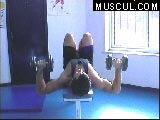|
||||
|
|
| ||||||||
|
|
We will take for example the Bench press. You can click on the image to open the demonstration. |
|||
 |
 |
 |
 |
| Dumbbells. | Cause problems of balance and trajectory to retain the symmetry of the two arms while executing the movement. Consequently, apart from the pectorals and the triceps, numerous fibres are involved in this work, as well as a large number of nerve connections. It is quite difficult to push the dumbbells along two parallel lines. The press must also be controlled to remain vertically above the shoulders. |
|
| Barbell. | We eliminate the need to control the parallel movement of the arms, since the hands stay in the same position on the bar. For the rest, however, the pectorals and the triceps still need to push symmetrically so that the bar rises horizontally. You must also control the press to make sure the bar remains vertical above the shoulders. |
|
| Convergent machine | The only control is that required to ensure that the pecs and the triceps push symmetrically. But even if you do not manage, the movement takes place anyway. No balancing work. |
|
| Traditional machine. | This is the worst. Apart from pushing, nothing else works. But worse still, it is impossible to tell whether both arms are pushing with the same force and, without realising it, since generally the left and right sides of our bodies are not developed in the same way, you increase the dissymmetry between the two sides. |
| Conclusion | The demonstration could be carried out with other shoulder, dorsal, arm or thigh exercises. Read Peter's testimony. In this field, the flashiest is not necessarily the most efficient. You could argue that machines offer safety and the guarantee that the movement will be carried out correctly. But don't you think it would be more intelligent to learn, using all the means our bodies provide, how to execute the movement properly. Pushing a load is good, it works a muscle, but doing a physical exercise does not "only" mean working the muscles, the brain must also take part in the action. I would not go as far as saying that nowadays, in fitness clubs, thanks to machines, the instructors can sometimes afford to make mistakes. There is also a lower risk of having an accident and less time is spent on explanations. But that would be unkind to say. In addition, machines give the impression of a healthy and tidy room - cleanliness is a must - whereas barbells sometimes tend to be left lying around on the floor. Managers then have to ask their customers to respect a certain amount of discipline. I would just like to make one small point concerning an excellent machine, often used too much and incorrectly by beginners who want to copy the pros, but who have no idea of the basic positions: the "cable crossover machine".
My idea of physical exercise is more aimed at working as naturally as possible, involving as many bodily functions as possible. From the medical point of view, however, for re-education or to finalise the preparation of top athletes, I can quite see the need for this type of machine. |